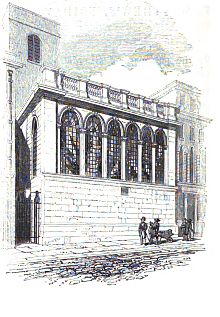St Matthew, Friday Street
| St. Matthew Friday Street | |
|---|---|
 |
|
| Location | Friday Street, London |
| Country | United Kingdom |
| Denomination | Church of England |
| Architecture | |
| Architect(s) | Christopher Wren |
| Style | Baroque |
| Demolished | 1885 |
St. Matthew Friday Street was a church in the City of London located on Friday Street, off Cheapside. Recorded since the 13th century, the church was destroyed in the Great Fire of 1666, then rebuilt by the office of Sir Christopher Wren. The rebuilt church was demolished in 1885.
St. Matthew was the only church in the City of London dedicated to the apostle and patron saint of accountants. Friday Street was so named, according to John Stow, after the fishmongers living there, although none are recorded in the parish records. Cheapside was the principal market street of medieval London (“cheap” meaning market) and many of the lesser streets running off were called after the commodity sold there, such as Milk Street, Bread Street and Wood Street. It is more likely, therefore, that Friday Street was so called from fishmongers vending, rather than living there.
The earliest surviving reference to the church is in a document from the reign of Henry III, as “St Matthew in Fridaistret”. A document from 1381-2 refers to the church as “St. Matthew in Chepe”.
In 1631, Hugh Myddleton, the entrepreneur who had engineered the New River to supply water to London (and which still survives between Hertfordshire and Stoke Newington) was buried in St. Matthew Friday Street. He had been a parishioner and churchwarden. When the church was demolished, 254 years later, an unsuccessful attempt was made to find his monument and coffin.
During this time, the rector of St. Matthew’s was the puritan divine Henry Burton. In 1636, he preached there that William Laud’s changes to church ritual were drawing the Church of England closer to popery and accused the bishops of being “caterpillars”, not pillars of the church. As a result, Burton was placed in a pillory and had his ears cut off. After Laud’s fall and execution, Burton published “The Grand Impostor Unmasked, or a detection of the notorious hypocrisie and desperate impiety of the late Archbishop (so styled) of Canterbury, cunningly couched in that written copy which he read on the scaffold”.
...
Wikipedia
